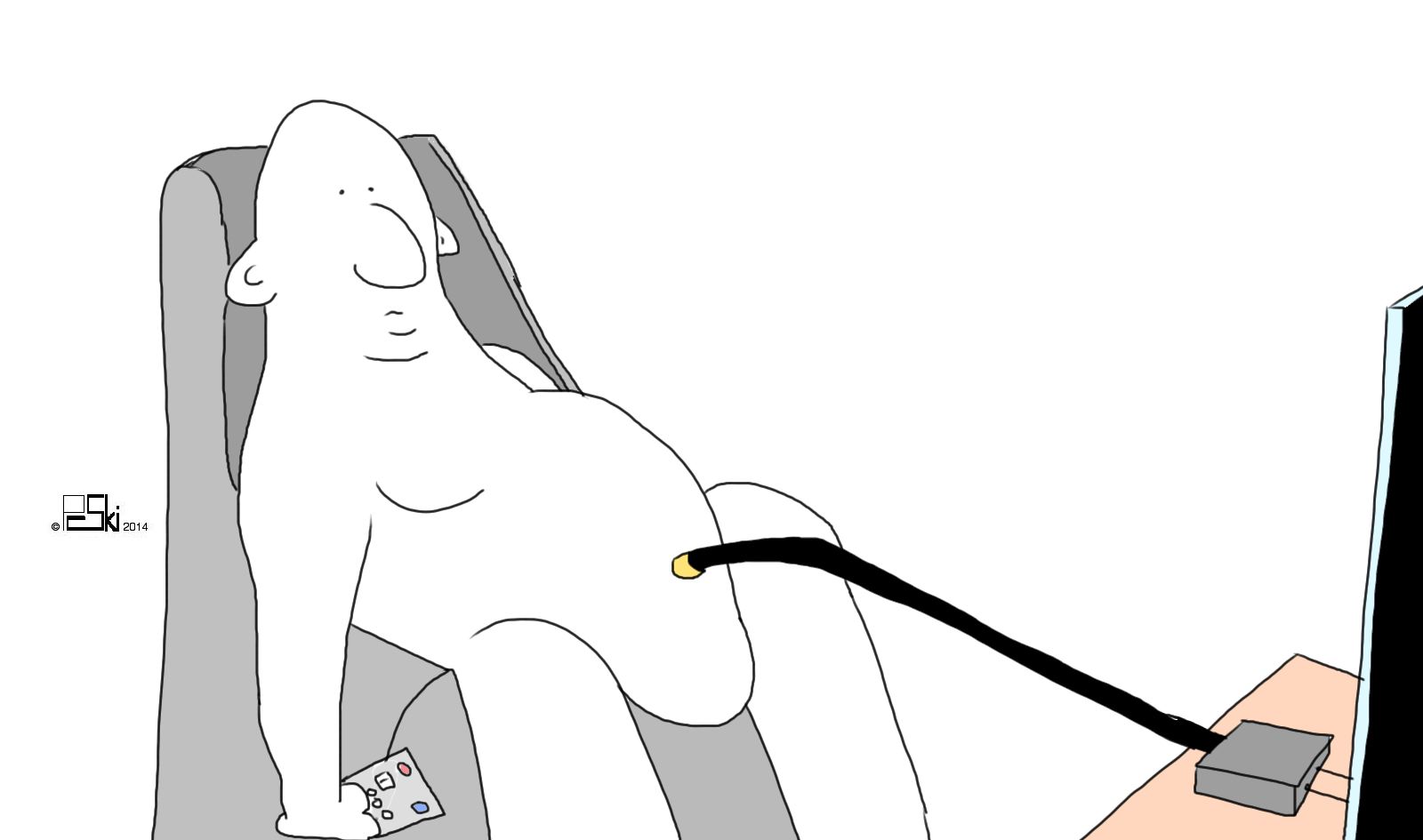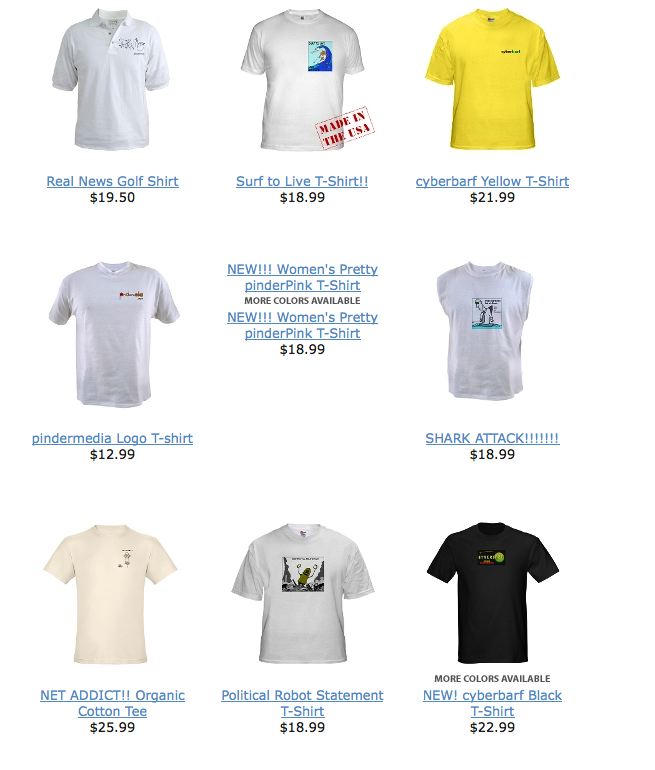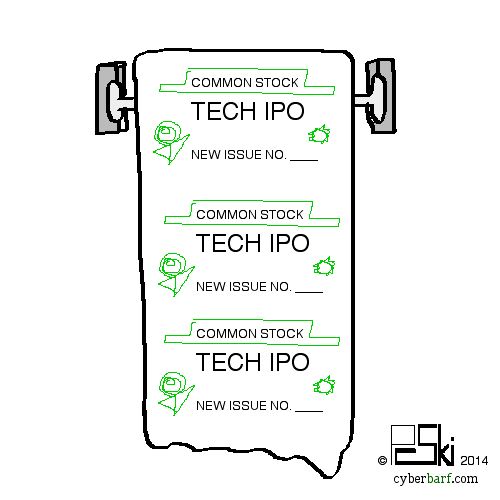|
cyberbarf VOLUME 14 NO. 1 EXAMINE THE NET WAY OF LIFE AUGUST, 2014
THROTTLED CORD CUTTERS BARFETTES iTOONS SOCIAL CHUM WHETHER REPORT NEW REAL NEWS KOMIX! SHOW HACK!
|
©2014 Ski All Rights Reserved Worldwide Distributed by pindermedia.com, inc.
|
|
cyberbarf EXAMINE THE NET WAY OF LIFE
QUICK & RELIABLE SERVICE
CYBERBARF T-SHIRTS, MUGS & MORE
PRICES TO SUBJECT TO CHANGE PLEASE REVIEW E-STORE SITE FOR CURRENT SALES |
NEW TO THE STORE CHECK OUT ALL THE STYLES!
THANK YOU FOR YOUR SUPPORT!
CYBERBARF
|
|
cyberbarf EXAMINE THE NET WAY OF LIFE cyberbarf THROTTLED ESSAY People will soon be learning more about what it means when the big back bone communication companies say they need to defend the last mile. The companies literally own the last mile to their customer connections. As such they control the gateways of service coming into the home or business. It is an extremely big deal when more and more consumers are ditching traditional coaxial wire for mobile or broadband access. But one of the issues remains that even if one ditches traditional cable, one still needs a hard wire connection somewhere down the line to get the data to their devices. Data users are taking on average 328 GB of data per month. Those lucky to have grandfathered unlimited data plans through their carriers are suddenly getting throttled by their companies. It has come to the attention of the FCC. Federal Communications Commission Chairman Tom Wheeler today sent a letter to Verizon Wireless, questioning that have unlimited data plans during peak usage times. Verizon first announced its intention to throttle high-usage customers on grandfathered last month. In the letter, Wheeler says that he is "deeply troubled" by Verizon's decision to throttle its unlimited users, and does not believe that the reason stated, network optimization, applies to the situation. Users who are mobile platforms using devices that take certain high bandwidth applications, such as streaming high-definition video or during real-connected to a cell site while it experiences heavy demand have found their connection speeds drop quickly. Considering what carriers charge for overage fees for going over one's limit (it could $1 per MB or more), a heavy data user on a 10GB data plan streaming movies could suddenly be charged an extra $300 per month if one does not have an unlimited plan. Carriers dropped those type of plans because the networks are getting clogged with information that was unbillable. There is still only finite bandwidth available for business and consumer use. However, there is a growing demand for bandwidth by people who have migrated to mobile and tablet devices to consume giant file size packets of information and video which used to be easily sent via cable wire to a TV box. Carriers claim this new consumer model is choking the system, which itself is leading to slower connection speeds for everyone. So in some form a vague equity, carriers are being to throttle those who pay less for more in order to even out the digital delivery playing field. If this was an electric grid on a hot summer day, one would call it rolling blackouts. But since people are so tied to their devices more than their own children, they get quite upset if they can't in an instant get the video gratification from the smartphone or page loads. In a growing entitlement society, not getting instant gratification is a now major consumer gripe. When you hear in the future the evil of throttling, one must read it in context of who is saying what to whom. The carriers and network connectors will say this is a huge traffic jam that threatens to down the entire internet and telecommunications grid. Consumer groups will complain that this is a hand grenade by the telecos to get consumers to pay more for prized access speed. In the end, no one is going to be happy.
cyberbarf CORD CUTTERS COMMENTARY
People hate their cable guy. Poor customer service, high rates and spotty service has caused millions of Americans to drop their cable plans. They are literally trying to cut the cord which brought hundreds of channels into their homes. But by doing so, these rebel consumers needed an alternative means to get their old favorite television shows. Insisting that it was not striking a blow against new communications technology, the Supreme Court this term smashed and shut down a unique way to deliver TV programs to those cordless audiences. It ruled that the engineers at the Aereo, Inc. had — so far — not found a way to avoid violating television network's copyright privileges by delivering their programs to Aereo's customers for a small monthly fee. The analytical technique the Court used in finding a likely copyright violation by Aereo was to compare its streaming of Internet-based TV cable TV systems’ snatching of TV broadcasts out of the airwaves for re-delivery to customers. The over-the-air TV broadcast industry had taken the case of American Broadcasting Companies v. Aereo to the Supreme Court, claiming its survival was at stake. Aereo’s system, the industry contended, was offering a very cheap version of TV programming to its customers without paying program license fees that cable operators have to pay. In essence, the new company was stealing copyrighted programs out of thin air and reselling it to consumers.
The threat was clear to the TV networks and their program developers. Aereo was going to take the networks’ own paying customers depriving it of revenues that have been replacing their declining take from advertising, the TV firms said. The Court, in its 6-3 ruling, said nothing about rescuing the TV broadcasters, but based its ruling on a fairly simple application of what to “perform” a copyrighted program through distribution to “the public. ” Aereo’s system, Justice Stephen G. Breyer wrote for the majority, performs the copyrighted programs and does so through delivery to the public. Aereo has developed a system in which it uses thousands of tiny antennas, each tuned to respond to an individual customer's Internet demand for a particular TV program, and through those antennas, it delivers to each customer only their own personal copy. Aereo contended that it supplying the technology hardware --like a DVD recorder which a home user can legally use to make a copy of a program beamed to his TV to watch at a later time --to enable its customers to get access to TV programs that were broadcast over free airwaves. The Court rejected that claim concluding that Aereo was not simply an equipment provider. It was capturing the signals then putting then retransmitting them to its customers. The downfall of the Aereo argument is that the end users did not own the antenna, but rented it. And unlike the noncommercial application of home DVD time shifting, Aereo was charging money to its end users, thereby unfairly profiting from the broadcaster's signals. Copyright attorneys universally said that the Court got the decision correct in this case. But there was a dark cloud in the silver lining of the opinion. The Supreme Court went to some lengths to show that it was issuing only a narrow ruling. It said it was dealing, at this point, only with system so far as it enabled its viewers to view copyrighted TV programs “live,” or after only a brief delay. Justice Breyer stressed that the said nothing about downloading a TV program in order to recover it and keep it on hand for somewhat later viewing. But the real elephant in the room is the out-of-the-home storage and retrieval of entertainment files. The real fear of new cloud based businesses would be caught in the Aereo web. Cloud services store copies of files on separate servers owned by the cloud company and rented to end users. It is more similar to the Aereo model than a consumer buying a hard drive DVD player and legally time shifting television programs for later viewing. The real problem comes with these new industries is the fact that they are charging money to hold or make copies of copyrighted materials without paying license fees. As the case had unfolded before the Court, many in the communications technology sector had worried that a ruling against Aereo would copyright restrictions on the modern phenomenon of “cloud computing” -- that is, downloading something from the Internet, and storing it on a third party drive. It will be time enough to deal with the “cloud,” the opinion said when an issue directly involving that technology gets before the Court. Breyer also said the new decision was not dealing with other potential time-shifting download technologies. But most legal experts believe that it would be an extremely difficult argument to distinguish between Aereo's services and those of cloud based ones. For cord cutters, the cloud could have been another avenue to find, store and watch their entertainment programs at cheaper rates than monthly cable charges. But for some, the whole reason secondary entertainment distributors are cheaper is that they don't pay any royalty fees for the content. It operates like peer to peer networks where members used to distribute, bittorrent and share shows and movies amongst themselves, creating a pirate system to get around royalty fees. Those services met their demise just as Aereo has.
For most people, there is no good alternative for getting over-the-air broadcast TV if you are not able to get a signal using a digital antenna. There are other devices and services that allow you to record over-the-air broadcast TV without subscribing to a cable TV service, but each of these solutions requires you get a broadcast signal on your TV using a digital antenna. And in many metro areas, these over-the-air digital signals are getting hit or miss. If the signal is not perfect, the receiver will give you a blue screen of death (no program available). Over the air digital signals are getting weaker, even in metropolitan areas like Chicago. It is not a priority for over-the-air stations to keep transmitting free signals to digital converter boxes when most people have access to cable and broadband services. That said, it's very likely that fewer people can access a broadcast TV signal today than a decade ago. The reason why is that in 2009, all TV broadcasters were forced by Congress to stop transmitting analog signals and instead transmit digital TV signals. While this change in technology offers many benefits, such as clearer picture and sound quality for viewers, as well as more efficient use of wireless spectrum, it also means that broadcasters have had to turn down the power on their signals, which has resulted in a shorter broadcast range. What's more, in the old analog world, you might have gotten a fuzzy picture if you were trying to tune in to a weaker broadcast signal. But in digital transmission, the signal is either there or it's not. If the signal is too weak, the viewer gets no picture or audio. According to CNET, this is happening as more people are starting to cut the cord and use the Internet to access most of what they want to view. The number of American households that no longer subscribe to a paid TV service increased 44 percent in the past four years to 7.6 million. In contrast, roughly 18 percent of all U,S, households have a Netflix or Hulu Plus account and do not subscribe to a paid TV service. Clearly, consumers want to shift away from the old cable model. One alternative is Slingbox, a device you can buy for about $150, that you install at a friend's or a family member's house who has cable TV. The Slingbox retransmits or redirects the TV signals that come into the cable household and then sends those signals over the Internet to a laptop; Internet TV device, such as an Apple TV; or a mobile device like an iPad. The downside to the Slingbox is that you can only watch whatever channel is being viewed by the folks at the Slingbox host site controlling the cable box. Thus, you are forced to watch whatever the host cable box is watching at that time. It would be easier to go to that home and wrestle away the remote control. While there is nothing illegal per se about streaming TV content from a Slingbox to another device outside the home, the service is not really meant to be shared with non-cable subscribers as a scheme to get around paying for a cable TV subscription. The service was meant to give cable TV subscribers options for watching a service they are already paying for, wherever they may be. That is why an increasing number of web streaming sites will ask you who your cable provider is before it will stream video to your computer. Another option is that broadcasters have having their own alternative distribution systems. One might consider for viewing live sports is subscribing to individual sports programming apps or websites. For example, Major League Baseball offers a paid mobile app that allows subscribers to watch live baseball games on smartphones, tablets or laptops. But keep in mind that some games may be blacked out if they're being broadcast nationally or locally. For live local news, some broadcasters have begun broadcasting their reports directly to mobile devices. But finding a local broadcaster that offers this is hit or miss, with some offering mobile signals in some markets and not in others. And you must have a device that's compatible with the mobile broadcast service in order to view the news program. And once you sign up for these apps, you will probably be subject to push advertisements and additional spam. Unless someone invents an entirely new distribution means, most Americans will be stuck with some kind of wired pay entertainment system.
cyberbarf EXAMINE THE NET WAY OF LIFE cyberbarf barfette It took many Wall Street analysts decades to realize what motivates Apple. In the past, analysts have harped on market share in the computer segments as the pulse of a company. But finally, several TV talking heads have come to realize that Apple is fine with having only a 30 percent share of the smartphone market with 70 percent of the profits. On the other side, lower cost Android phones may take up 70 percent share of the market, but with only 30 percent of the profits. It seems some investment bankers are starting to realize that real profits really matter, and that companies like Samsung are getting squeezed by their rush to growth. barfette The on-line advertising business is still growing, but there still is confusion on what it really means. There is no foolproof way to measure the real viewers of on-line advertisements. Click ads can be manipulated by host bots. There is no universally acceptable on-line rating bureau that can audit numbers like there is in standard television and newspaper circulation. As a result, on-line ads have come even with print ads, but rarely do they pull in ten percent of the gross ad price. The only way an advertiser can really tell someone is buying their product from the digital world is through regulated in-app purchase links, which many e-retailers have had to throttle back due to parent and FTC complaints of children being tricked into expensive upgrade purchases. barfette In the world of tech wearables, a 22-year-old female engineering student in India has created a rape repellent bra. The amount of brutal abuse and rape of women in India has led to an international outcry. The student's invention is called Society Harnessing Equipment, or SHE for short. The bra contains a pressure sensor connected to an electric circuit that generates a shock of 3,800 kilovolts, which is severe enough to stun an attacker and severely burn his hand. The moment its pressure sensors are activated, the bra’s built-in GPS also alerts the police and the victim’s parents to the location where the attack is taking place.
|
|
THE PINDERMEDIA STORE IS FULL OF FUN T-SHIRTS CLOTHES, HATS AND OTHER ITEMS. CHECK OUT THE STORE FOR ITEMS
SUPPORT cyberbarf VISIT THE CYBERBARF STORE! Prices and styles may vary depending on sales, allotments, inventory. |
|
cyberbarf.com EXAMINE THE NET WAY OF LIFE iToons
cyberbarf SOCIAL CHUM DATA CHURN So much for putting one's toe in the water, then later learning that we are all Facebook chum in its shark tank. As Arstechnica reported, Facebook scared some of its privacy-conscious users when it revealed that it had performed a scientific study on manipulating the emotional content of users' News Feeds. Since the study came to light, the company has been accused of acting unethically—even illegally—by subjecting its users to an experiment without notice or consent. The Facebook study allegedly gathered data of “emotional words” to see how the overall mood of a user's News Feeds affected that user's status updates. Some call this data spying. It turned out that users who saw fewer positive sentiments in their feeds produced fewer positive status updates, and users who saw fewer negative sentiments in feeds produced fewer negative updates. In any scientific experiment, students observe a hypothesis and write down the results to compare to other studies. In human studies, observers take down reactions to stimuli. Afterward, science researchers compare notes and come to conclusions. In the Facebook study, the effect was small, to the tune of one less positive or negative word generated per 1,000 emotional words in News Feeds, but it did exist. Facebook's defense of the study that the effects of the study have been overstated, the experiment was short and no one was harmed. However, if this was a human study, many critics said it violated ethical laws by conducting experiments on its users without their informed consent under federal guidelines. Facebook has since announced that the study did not receive federal funding, so it wasn't subject to those ethical regulations. However, there is a gray area since some of the authors of the report did receive federal funding or were subject to those guidelines. But from a PR standpoint, it is just creepy. Facebook is a known data miner of fat hog proportions. It will see your data, your likes and jam those results into an algorithm to push specific advertising to your home page. Data is like oxygen to the beast. By studying the information and reaction of individuals to News Feeds, Facebook claims that it can improve its service. Because of Facebook's size, a large amount of content comes unfiltered to an individual News Feeds. For many people, the feed like a monsoon of information. Like it or not, Facebook has therefore made the decision to manage News Feeds. Facebook has been managing these feeds so it finds itself in the position of choosing what most users see. If what they see produces emotional effects, Facebook would therefore be responsible for influencing—even in a small way—the emotional lives of millions of users. Subliminal manipulation is like subliminal advertising, something critics find unethical and immoral. Even if the Facebook study was conducted in a way that was no worse than the average market research, the company's capacity for collecting information on its users makes it worth asking how this information will be put to use. There is a responsible way to use it, and then surely many more practical ways involving advertising, user retention, and more metrics Facebook would likely love to increase. The behind the scenes way Facebook treats its users is like a mosquito sucking all the blood from a victim. It could lead to uncontrollable circumstances like falsification of individual News Feeds to create fake endorsement that friends would pick up on. The only thing Facebook has to sell is its data collection. Marketing groups and advertisers love to see data and demographics culled together to create target marketing strategies. Facebook is one of the few companies that has corralled enough sheep to make large and detailed studies of people likes, dislikes, tastes and opinions without paying a dime to the subjects. |
|
cyberbarf THE WHETHER REPORT |
cyberbarf STATUS |
| Question: Whether the U.S. Supreme Court's patent rulings against vague software patents will change the IP landscape? |
* Educated Guess * Possible * Probable * Beyond a Reasonable Doubt * Doubtful * Vapor Dream |
| Question: Whether the increased combat zones over commercial aviation airspace will spur development of airliner defense systems against missile attacks? |
* Educated Guess * Possible * Probable * Beyond a Reasonable Doubt * Doubtful * Vapor Dream |
| Question: Whether the FAA, state and local government regulators will crack down on the use of civilian drones to the point of mandating operator licensing, training and permits to fly drones for any purpose? |
* Educated Guess * Possible * Probable * Beyond a Reasonable Doubt * Doubtful * Vapor Dream |
|
cyberbarf EXAMINE THE NET WAY OF LIFE |
What you see is what you get. --- Flip Wilson |
|
BACK IN BLACK WITH THIS CLASSIC CYBERBARF T-SHIRT!
FEATURING: THE REAL NEWS IMPACT EDITORIAL CARTOONS WRIGLEYVILLE WAR POLITICS ENDORPHIN RUSH THE DARK ABYSS RANDOM ELECTRONS SPECIALS
FEATURING: THE REAL NEWS ARCHIVES CARTOONS MADAME'S TEA HOUSE THE BAR EXPLORE THE CITY SCAPE UNDER CONSTRUCTION SURPRISES ESTORE SPECIALS |
NEW THEORIES AND ESSAYS
cyberbarf
THE STEAM PUNK SPECIAL EDITION featured new Music from Chicago Ski & the (audio) Real News: (mp3/4:14 length)
EXAMINING THE NET WAY OF LIFE cyberbarf™ distributed by pindermedia.com, inc.
|
cyberbarf
Distribution ©2001-2014 pindermedia.com, inc.
All Ski graphics, designs, cartoons and images copyrighted.
All Rights Reserved Worldwide.



















